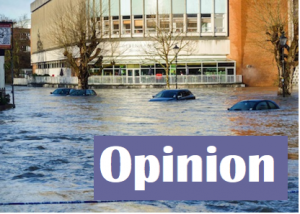 Abraham Lincoln
If given the truth, the people can be depended upon to meet any national crisis...
Abraham Lincoln
If given the truth, the people can be depended upon to meet any national crisis...
 Guildford news...
for Guildford people, brought to you by Guildford reporters - Guildford's own news service
Guildford news...
for Guildford people, brought to you by Guildford reporters - Guildford's own news service
The Dragon Says: Why Wasn’t The Flood Alert for Guildford Issued Earlier?
Published on: 27 Dec, 2013
Updated on: 27 Dec, 2013
 Some serious questions need to be asked after Guildford’s Christmas floods. The questions need to be asked of those responsible for issuing flood warnings and those taking the necessary precautions.
Some serious questions need to be asked after Guildford’s Christmas floods. The questions need to be asked of those responsible for issuing flood warnings and those taking the necessary precautions.
One question above all stands out. Why, when severe weather warnings had been issued days before and a flood alert was issued by the Environment Agency for the Upper Wey during the early evening of Monday, December 23rd, was no alert issued for Guildford until 10.11 am on the 24th, when the river had already broken its banks?
It seems unbelievable. A storm was lashing the country for most of the 23rd with constant rain onto already saturated ground. You did not need to be an expert to realise that all the rain falling on the 904 square kilometres of the Wey (North and South) catchment, from parts of Surrey, Hampshire and West Sussex, has to eventually drain into the river.
This must have been realised and an alert was issued for the Upper Wey but none for Guildford and the Lower Wey. Why? The water had to go somewhere and the water in the upper river will inevitably move downstream; we all know that’s how it works.
It is true that levels can be managed through the sometimes heroic work of the lengthsman and weir-keepers, but they can only do so much to prevent nature and the floodwater taking their course.
So when all the clear up and recovery work has been completed there needs to be a root and branch review to investigate the actions that led up to the floods and discover what lessons can learnt for next time.
 There will definitely be a next time. Of course there will. The world turns, rain falls and rivers flood. It could be next week, next year or perhaps a decade or two, who knows? But it will happen and those in charge then should have the benefit of our experience so that they can avoid any mistakes we have made.
There will definitely be a next time. Of course there will. The world turns, rain falls and rivers flood. It could be next week, next year or perhaps a decade or two, who knows? But it will happen and those in charge then should have the benefit of our experience so that they can avoid any mistakes we have made.
In times of emergency connected to the weather it is vital, that wherever possible, early warnings are given so that the authorities, the councils and the emergency services can be warned and put well considered and properly communicated contingency plans into effect.
Low lying homes and businesses must be alerted as soon as possible so that they can move as many valuables as possible to higher levels. Low lying car parks should be closed so that cars are not submerged and road and traffic management plans must be put in place to maintain flows and ensure the passage of emergency vehicles.
The local media must play their part too. They must be available 365 days of the year to pass on information and keep everyone informed of news and official advice.
Guildford’s position in a river valley means that periodic flooding is inevitable. The Saxons, who first settled here, understood that, which is why the first buildings were probably built around St Mary’s church, in Quarry Street, well out of the reach of the deepest flood water.
But today, perhaps with a degree of arrogance that comes from our ability to control more and more in the natural world, we seem to have forgotten some essential lessons: when you live in the flood plain, have a plan, be ready to move quickly when the river starts to rise and don’t wait until it is too late.
Responses to The Dragon Says: Why Wasn’t The Flood Alert for Guildford Issued Earlier?
Leave a Comment Cancel replyPlease see our comments policy. All comments are moderated and may take time to appear. Full names, or at least initial and surname, must be given.
Recent Articles
- Surrey Police Spent £23 million on Aborted Move to Leatherhead
- Letter: Planned ‘Devolution’ Will Not Help the Voluntary Sector
- ‘Unaltered’ Plan for 25-storey Block in Woking Resubmitted and Recommended for Approval
- School Head Says There Should Be VAT Exemptions for SEN Kids
- SCC Leader Seeking Postponement of County Council Elections to Focus on Devolution
- Letter: Banning Cousin Marriages Would Be Wrong
- Column: Guildford’s MP Writes – Greener, Fairer, Thriving
- Deepcut To Become the First New Parish in Surrey This Century
- Notice: Run for Charity
- Letter: Happy New Year


Recent Comments
- Mike Smith on SCC Leader Seeking Postponement of County Council Elections to Focus on Devolution
- H Trevor Jones on Column: Guildford’s MP Writes – Greener, Fairer, Thriving
- Jules Cranwell on Column: Guildford’s MP Writes – Greener, Fairer, Thriving
- Ricky Sonn on Column: Guildford’s MP Writes – Greener, Fairer, Thriving
- Stephen Spark on Column: Guildford’s MP Writes – Greener, Fairer, Thriving
- David Wheeler on Football Pitches Approved as Part of Secretts Redevelopment
Search in Site
Media Gallery
Dragon Interview: Local Artist Leaves Her Mark At One of England’s Most Historic Buildings
January 21, 2023 / No Comment / Read MoreDragon Interview: Lib Dem Planning Chair: ‘Current Policy Doesn’t Work for Local People’
January 19, 2023 / No Comment / Read MoreA3 Tunnel in Guildford ‘Necessary’ for New Homes, Says Guildford’s MP
January 10, 2023 / No Comment / Read More‘Madness’ for London Road Scheme to Go Ahead Against ‘Huge Opposition’, Says SCC Leader
January 6, 2023 / No Comment / Read MoreCouncillor’s Son Starts Campaign for More Consultation on North Street Plan
December 30, 2022 / No Comment / Read MoreCounty Council Climbs Down Over London Road Works – Further ‘Engagement’ Period Announced
December 14, 2022 / No Comment / Read MoreDragon Interview: GBC Reaction to the Government’s Expected Decision to Relax Housing Targets
December 7, 2022 / No Comment / Read MoreHow Can Our Town Centre Businesses Recover? Watch the Shop Front Debate
May 18, 2020 / No Comment / Read More










Jim Allen
December 27, 2013 at 11:17 pm
What can one say but hear hear! It took over two hours for the police to turn up at Clay Lane to offically close the road on Christmas Eve.
Mary Bedforth
December 28, 2013 at 10:36 am
An excellent report if I may say so. If only we had similar leading editorials elsewhere in our local press!
I am referring to the days of the late Ted Adams. My family contributed to this appeal.
http://www.tedadamstrust.org.uk/history.htm